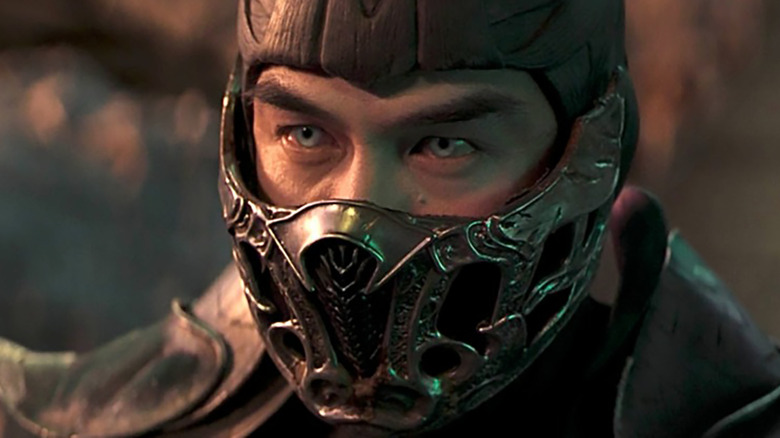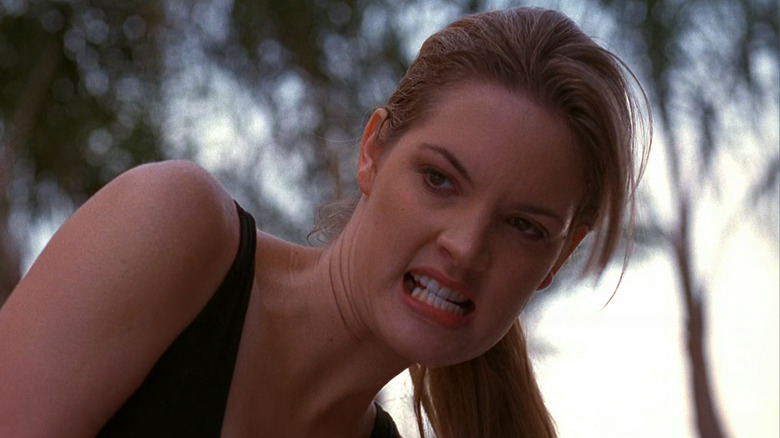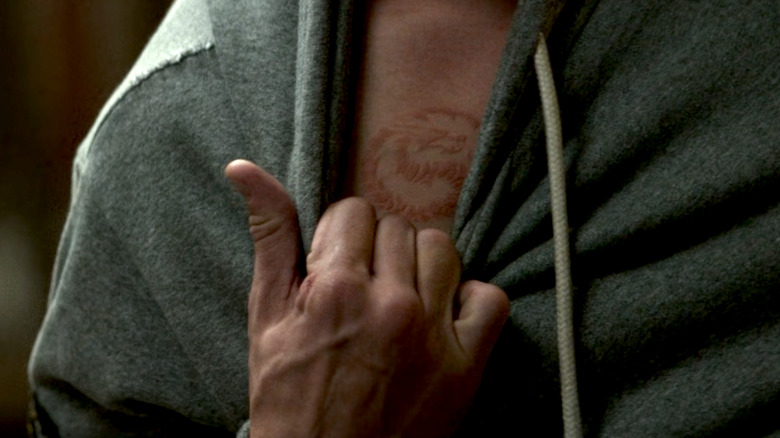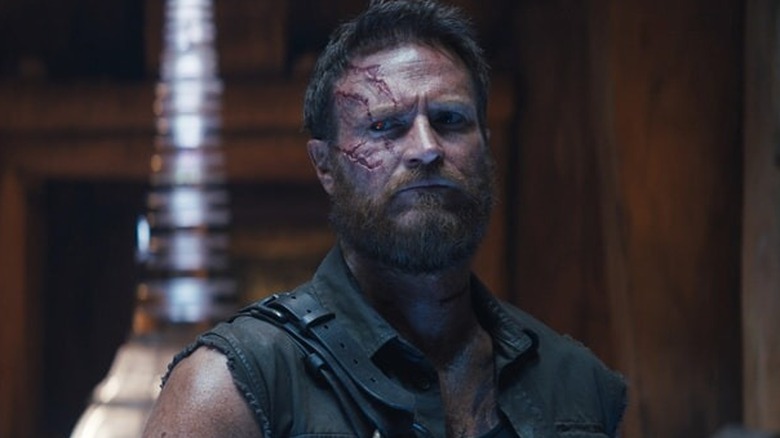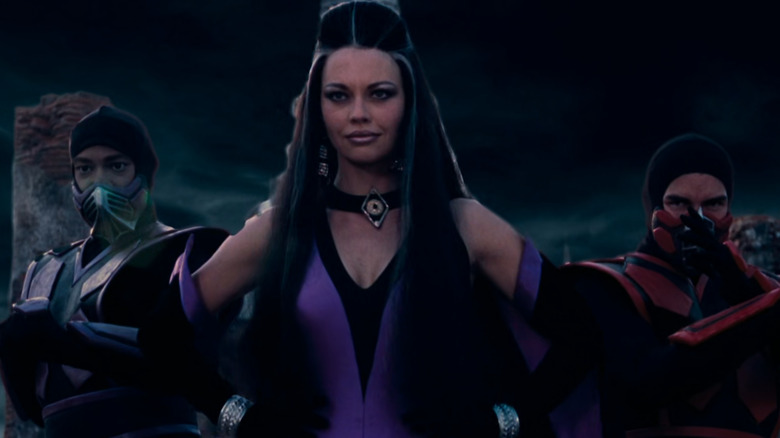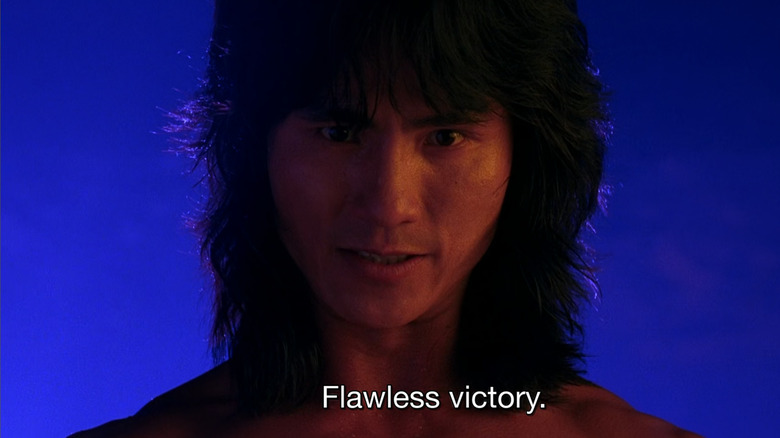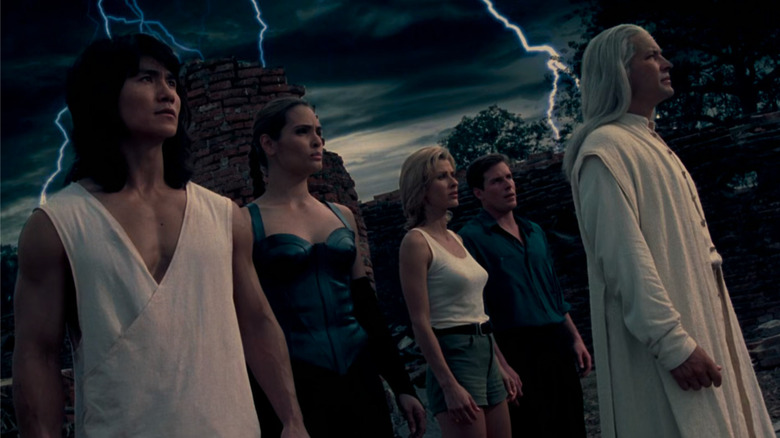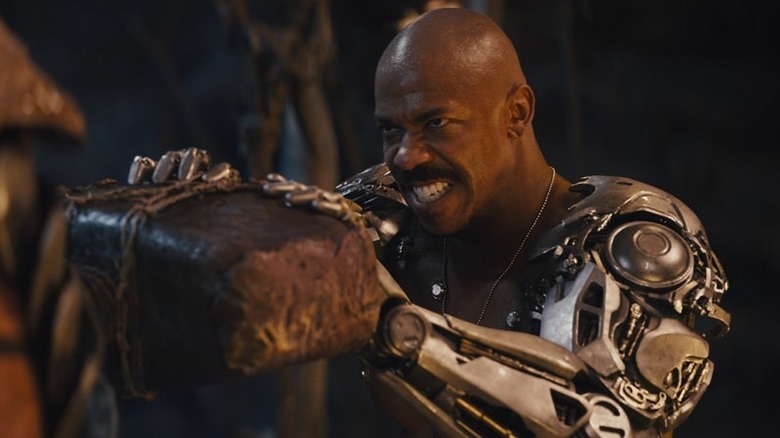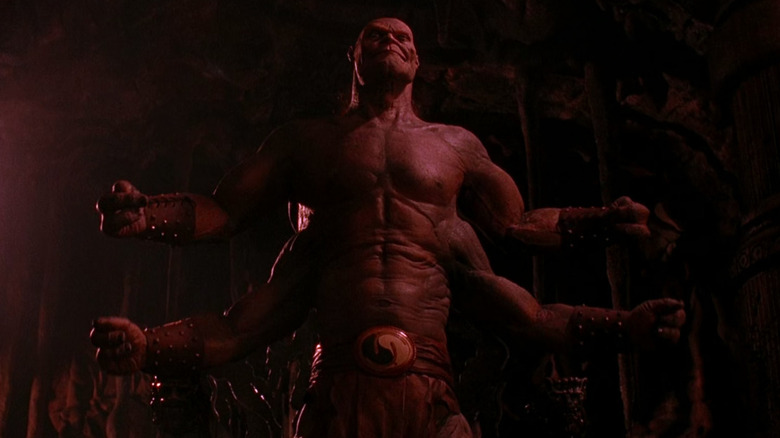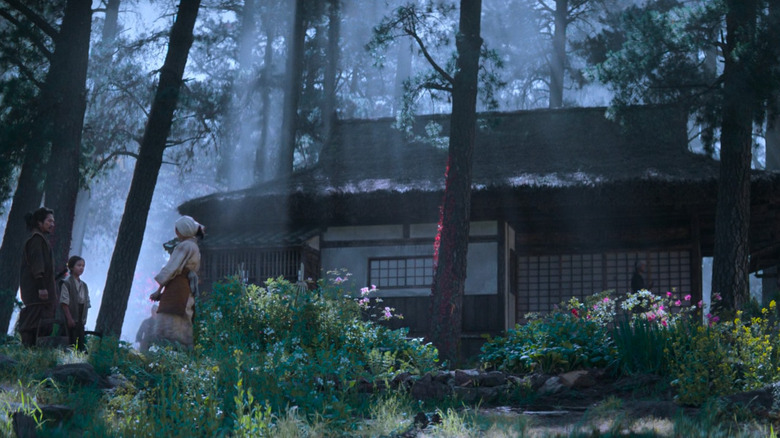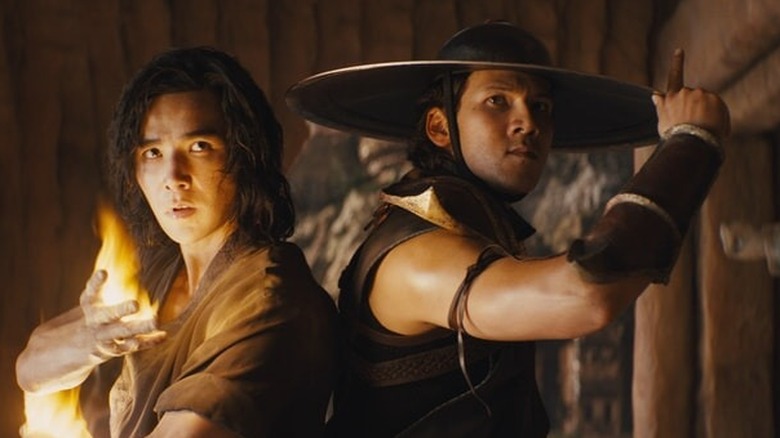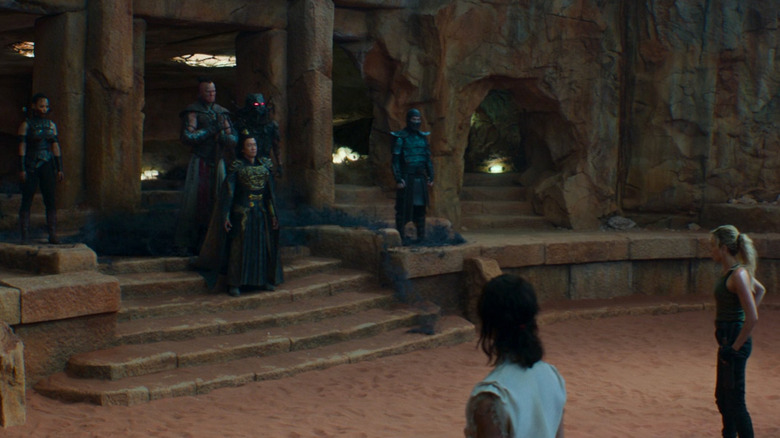Things You Only Notice In The Mortal Kombat Movies After Watching Them More Than Once
The "Mortal Kombat" franchise has a special place amidst the ranks of video game royalty, and so do its movie adaptations. The 1992 video game and its sequels made waves upon release for their unprecedented levels of violence and gore, and three years later, the "Mortal Kombat" movie unleashed equally unprecedented levels of cheesiness and camp. There isn't any video-game-turned-movie series with a bigger disparity in rating, tone, characters, and content, and yet somehow, both games and films are legendary in their own right. As you could probably guess, the more you watch them, the more weirdness there is to unearth.
You can't blame the film studios for the strange state of their stories — it's not easy building a feature-length adventure from a game whose levels are only about 30 feet long and exclusively feature only two characters in profile. For better or worse (in the case of "Mortal Kombat: Annihilation," definitely worse), the studios took the challenge head-on, producing a series of movies you either love to hate or hate to love. Join us as we flip into the arena, blare the greatest theme song in cinema history, and explore the things you only notice in the Mortal Kombat movies upon repeat viewings.
The Kombat in the classics isn't particularly Mortal
Imagine you're a Hollywood creative tasked with building a movie out of the most violent video game in history, one so brutal it almost single-handedly led to a series of United States Senate Hearings on Violence in Video Games. For all the controversy, the game is extremely successful, and its avid fanbase is sure to demand that the spirit of the game survive the adaptation. You'd make a similarly brutal movie, right? Well, maybe you would, but director Paul W. S. Anderson and the rest of the creative team saw things differently, as they made perfectly clear in the first "Mortal Kombat" movie in 1995.
By the end of the first "Mortal Kombat," only six champions have died — Kano, Scorpion, Sub-Zero, Goro, Reptile, and Shang Tsung — and for most of them, their deaths are either tame or not even shown on-screen. Sonya snaps Kano's neck, but only when the camera cuts away to her snarling face. Scorpion explodes, but only once he's reverted to his skeleton form, preventing most of the potential gore. Sub-Zero simply freezes to death. Goro dies after falling out of sight. Reptile is crushed by Liu Kang but, of course, it occurs off-screen. Even the central villain, Shang Tsung, dies by falling onto a spike — only shown for a moment and producing no blood. Every other champion lives, which makes the movie's Kombat not quite so Mortal.
Dragon markings make no sense
The 2021 reboot, also simply known as "Mortal Kombat," improves on the '90s movies in a lot of ways, but that doesn't mean it doesn't have its own flaws. One of the biggest is the idea of the dragon markings, serpentine birthmarks that signify Earthrealm's champions and eventually give them their powers. The movie spends a fair amount of time explaining the marks and the rules regarding how they work, which is an odd choice, especially when the rules begin to make no sense the more you think about them.
For reasons unknown, only Earthrealm's champions have special marks, not those from any other realm (and there are many). They pass down from parent to child, though it's never explained what happens if a parent has more than one kid, begging the question: Could someone with a mark spawn multiple children in order to create an army of super-powered defenders of Earth?
The markings also transfer to anyone able to kill a marked champion. What would happen if the killer had an accomplice who contributed as much to their victim's death as the killer, or one who dealt a simultaneous killing blow? Would Earth gain two champions? Even more baffling: Since the champions of Mortal Kombat aren't restricted to certain species (or even biological organisms or living beings), what would happen if a lion mauled a champion and killed them? What if a strain of flesh-eating bacteria killed a champion? Would Earth's newest champion be the single bacterium that ate the most flesh?
They sure are lucky to have Josh Lawson
The 2021 "Mortal Kombat" features an ensemble cast, as diverse as it is expansive, that brings to life a number of the franchise's most iconic characters. Unfortunately, some characters end up more alive than others, thanks in large part to who portrays them. In the case of Kano, actor Josh Lawson managed to make the ruthless mercenary as credible and vibrant as any character in the whole series, practically carrying the movie on his leathery, tattooed shoulders. The more times you watch "Mortal Kombat," the more you realize that the whole cast and crew are lucky to have Lawson onboard.
Lawson, who you might also recognize from "Anchorman 2: The Legend Continues" and "House of Lies," displays an almost Ryan-Reynolds-level talent for self-referential, smarmy, sarcasm, peppering every one of his scenes with witty quips and actual, cheese-less comedy. When Sonya Blade eventually kills Kano, the remaining 15 minutes or so noticeably lack the levity that makes the middle section so fun. Luckily, the universe of "Mortal Kombat" rarely treats a character's death as final, and Kano has a shot at redemption in the possible "Mortal Kombat 2." Lawson himself has expressed his desire to return, telling BackstageOL that "I hope there's a sequel because I would love a chance for Kano to come back bigger and better. Kano 2.0. Just you wait. There's more life in the old girl yet."
The creators know their canon ...
For all the criticism you can levy on the "Mortal Kombat" movies regarding almost every aspect of production and storytelling, one thing you can never say is that the creators failed to study up on the franchise's lore. Every movie is packed from start to end with fan service and easter eggs, some of which refer to video game assets many players may have never even discovered.
Even the unpopular opening sequence in "Mortal Kombat: Annihilation," for all its faults, is still filled with deep-cut references, including some exceptionally obscure characters. When Shao Kahn opens his portal to Outworld and brings his new champions through, there are some surprising inclusions — there's the centaur Motaro (who didn't appear in the games until "Mortal Kombat 3" and was only playable via a secret code), purple ninja Rain (originally a fake character meant to tease "Mortal Kombat 3" players, as per an interview with Playstation Blog), and Ermac (who only existed as a rumor among players in the first two games, inspiring developers to finally make him real in "Mortal Kombat 3").
The other movies have references to other characters, as well, such as Sonya Blade's wall of research in the 2021 "Mortal Kombat" including pictures of Nightwolf and Kotal Kahn. There are also a myriad of specific signature moves, fatalities, and brutalities ripped straight from the games, and of course, a ton of iconic lines from the franchise's history.
... then choose to forget it
Despite all the dialogue that the Mortal Kombat movies adapt directly from the video games — like the 1995 film using original Scorpion voice actor (and franchise co-creator) Ed Boon's actual in-game audio for "Get over here!" — they also have a tendency to force that dialogue in, disregarding the canon and context that actually make it work.
One of the most glaring examples comes during the climactic final fight in the 1995 movie when Liu Kang finally defeats Shang Tsung. Standing over Tsung's dead body, Kang proudly shouts out "Flawless victory," despite the fact that the single condition for a flawless victory was never met: Not only does Kang take damage during the fight, he actually spends almost the entire time getting beaten and thrown around by Tsung until his sudden, dramatic comeback.
The first movie also includes another of the franchise's biggest snubs to canon, this time in the form of Scorpion's signature kunai, or lack thereof. Scorpion's famous ranged attack, accompanied by the aforementioned "Get over here," is probably the series' most iconic image and catchphrase, yet the movie decided to completely rewrite it. They changed his signature chain and kunai, an iconic ninja weapon, into an oily, alien tentacle monster, making Scorpion less of a mystical ninja warrior and more of a monster from John Carpenter's "The Thing."
Annihilation doesn't know what sequel means
Regardless of your feelings about the Mortal Kombat movies, there is no denying that with every subsequent watch, "Mortal Kombat: Annihilation" becomes an even more subpar sequel. Why its creators chose to start the film mere moments after the end of the first film, knowing full well that they were going to make wild changes to what it established, is beyond us.
To begin with, Robin Shou returns as Liu Kang, but not a single other Earthrealm champion is played by the same actor. Recasting is understandable, and the replacements were chosen well enough that you might not even notice some of them on your first watch, but replacing almost every hero is not a good way to build on the first movie's momentum. On top of that, the champions aren't even wearing the same clothing as they were mere moments earlier, at the end of the previous film. Sonya's red sweater has become a sheer, white tank top. Kang's dirty tank has become a pristine monk's shirt. Rayden's tattered robes are suddenly new and whole. Even worse than all of that, however, is the fact that Johnny Cage dramatically takes his trademark sunglasses off — the same ones that Goro made a grand show of destroying in the first movie.
What is Jax's power?
You can easily watch all three live-action Mortal Kombat movies without questioning Jax as a character. He's big, muscly, and his big, muscly arms are made of metal — that's a fine place to stop digging into Jax and just accept his presence among the magic ninjas and elemental sorcerers. But the more you watch the movies, the more you're left questioning exactly what the deal with those arms really is — and the 2021 film only makes the questions even more baffling.
1995's "Mortal Kombat" ignored the topic of Jax's mechanical arms completely, leaving it up in the air whether or not they are a power, powered armor, or prosthetics — and if the latter is the case, did Jax lose his arms due to injury and require the replacements, or did he purposefully remove them to add the robotic arms as weapons? "Mortal Kombat: Annihilation" reveals a bit more, at least, as it shows Motaro referring to the arms as weapons and ripping one from Jax's body. Jax himself then tears off the other, revealing two intact (and jacked) arms.
The 2021 "Mortal Kombat," however, shows Jax lose his arms, receive simple, mechanical replacements, and then activate his Arcana power in order to upgrade the arms into more sophisticated cybernetic constructs. We can only guess that his power is some form of technomancy, but the specifics remain completely unknown.
We're not sure Goro actually has four arms
In the "Mortal Kombat" lore, Goro is a Shokan, and like all Shokan, he has four arms. When you first see him brought to life as a combination suit and puppet in the first movie (especially if you saw it in 1995), the fearsomeness of his four massive limbs makes him seem monstrous, terrifying, and a very real threat. The same can be said for the CGI Goro in the 2021 movie, whose animation is solid and whose wholesale destruction makes him equally fearsome. Sadly, with every subsequent watch, Goro's four arms — really, his only gimmick — begin to seem like less and less of a factor until they might as well not exist.
If you watch Goro's scenes, whether they involve animatronics or CGI, you'll eventually notice that his additional two arms aren't actually that additional — they tend to simply follow whatever the primary set are doing. To create the illusion of independence, whichever arms aren't the focus of Goro's actions simply curl and uncurl their fingers, perhaps adding a small flex at the elbow for good measure. The sole exception to this unfortunate rule comes during the iconic scene in which Johnny Cage punches Goro in the Shokan family jewels. While two hands grasp the injury in pain, the other two reach out, as if to ask, "Oh Shokan God, why?"
Wait, why are we in feudal Japan?
The 2021 "Mortal Kombat" begins with a cool introduction sequence set at the Hanzo Hasashi Compound in 1617 Japan. The scenes quickly set the stage for the movie, with their verisimilitude and violence making it clear that we're not in the budget-cutting, campy territory of "Mortal Kombat: Annihilation" anymore. The sequence also sets the story in motion, establishing Cole Young's lineage, Scorpion and Sub-Zero's rivalry, and the mystical nature of the combatants involved. Many fans were just grateful to see the movie kick off with a more mature, serious tone than past live-action films, and so they may have overlooked one big detail until watching again: There is absolutely zero reason whatsoever for this scene to take place in feudal Japan.
To be fair to the sequence, we'll tally both the pros and cons of its 1617 setting. Pro: Scorpion and Sub-Zero are really old now, which we suppose is kind of cool. Con: Cole would be a descendant of Hasashi/Scorpion whether the scene was set 400 years ago or 40. Scorpion could just as easily have been Cole's father or grandfather, establishing a personal relationship between the two and raising the stakes exponentially. Instead, he's Cole's ancient ancestor and therefore a complete stranger, all seemingly for the purpose of a pretty set piece.
Not all fighters are created equal
Everyone has their favorite fighter in the "Mortal Kombat" universe — no one's choice is more correct than anyone else's. Yet the more you experience the characters, especially after watching the movies more than once, the more you start to realize that some are just better fighters than others, and it's just a fact.
Liu Kang, for example, seems impressive at first, throwing fireballs from his hands and feet, but eventually, you realize that Scorpion has those same powers, plus a few other major skills to boot. He manipulates fire and shoots fireballs like Kang, but he can also breathe it from his mouth, and even use it to teleport through space and between realms.
Another example is Reiko, the hulking, hammer-wielding foe who is meant to challenge Jax. Unfortunately for him, his power is merely a slight increase in physical strength over most people — a power nearly every champion has to some degree or another. Even characters whose powers seem at least decently useful, like Kung Lao and his telekinetically-controlled hat, have to feel a twinge of jealousy towards a fighter like Reptile, who is super strong, super agile, can climb on walls, shoot acid spit, and turn invisible.
The Mortal Kombat tournament isn't a tournament
Easily the biggest derivation from the "Mortal Kombat" games to the movies is the shift away from one-on-one duels in pre-prepared arenas to a general series of fights between whoever is around and looking to tussle. That's understandable at first — after all, stories and movies don't work quite so well when they simply jump from action scene to action scene with no explanation or development. After you watch more than once, however, you may start to notice that the characters are constantly talking about Mortal Kombat as a tournament, even going so far as to explain the rules and break the tournament down into qualifying rounds. It's a shame, then, that no tournament ever takes place.
The characters in the 2021 movie spend around an hour preparing and training for the upcoming tournament, and when it finally seems ready to begin, it just ... doesn't happen. Shang Tsung teleports his fighters to meet Raiden's, but instead of the legendary tournament that he and Raiden have hyped up, the many champions just descend into a melee of martial arts and magic. The first two movies fall into the same trap, one that becomes more and more obvious after watching them on repeat.
